Defeat of the Russian Army on the Yalu River
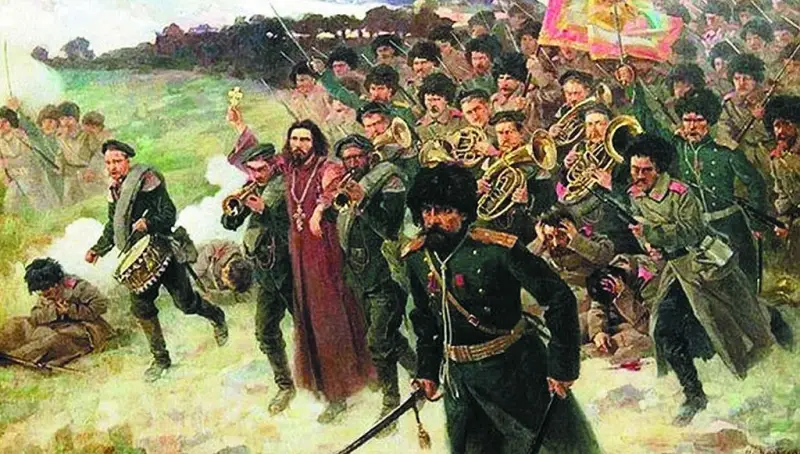
Regimental priest Stefan Shcherbakovsky in the battle of Tyurenchen (1904). Hood. Moses Maimon
General situation. Marine Theater
The Japanese United Fleet blocked Port Arthur and covered the landing forces, which were calmly transferred from the Japanese islands to Korea. The Russian Pacific Fleet, weakened at the very beginning of the war, and the Russian Manchurian Army, whose deployment dragged on for a month and a half, were unable to prevent the Japanese from landing troops and completing the main task of the initial stage of the war.
The unfavorable development of the situation in the Far East and especially the passivity of the Port Arthur squadron forced the Russian high command to think about appointing a new commander fleet Pacific Ocean. He became a talented commander, the famous Arctic explorer and scientist Vice Admiral Stepan Osipovich Makarov, who commanded Kronstadt.
Makarov was not liked at court for his “restless character,” but it was he who foresaw the sad outcome of the war if measures were not immediately taken to increase the combat effectiveness of the armed forces of the Russian Empire, especially in the Far East. Makarov served in the Far East for a long time, knew the theater of military operations well, so they chose him.
Before leaving, Makarov proposed that the Naval Ministry solve a number of important problems. The admiral insisted on the immediate transfer to the Far East of a detachment of ships under the command of Rear Admiral A. A. Virenius (battleship, two cruisers of the 1st rank, 7 destroyers and other ships). However, the Navy Ministry did not support this plan. Virenius's detachment, which was already off the coast of the Arabian Peninsula, received orders to return to the Baltic, to Kronstadt.
Taking into account the fact that the Pacific squadron did not have a sufficient number of destroyers necessary for maneuver warfare and protection of ports, coasts and other local tasks, Makarov proposed sending additional destroyer forces to the Far East. It was planned to transport 8 disassembled destroyers by rail (such experience already existed) to Port Arthur and begin construction of a series of 40 small destroyers. However, this proposal did not meet with understanding at the top. The Pacific Fleet was not strengthened.
Arriving in Port Arthur, Makarov began vigorous activity.
The Port Arthur squadron stopped “hiding” in the inner harbor of the fortress and began to go out to the open sea. During the short time under the leadership of Vice Admiral S. O. Makarov (just over a month), the Pacific Squadron sailed into the Yellow Sea in search of a meeting with the Japanese United Fleet six times. During the rest of the war with the Japanese Empire, the Russian fleet went to the open sea only three times: once under the command of Vice Admiral O. V. Stark and twice under the command of V. K. Vitgeft.
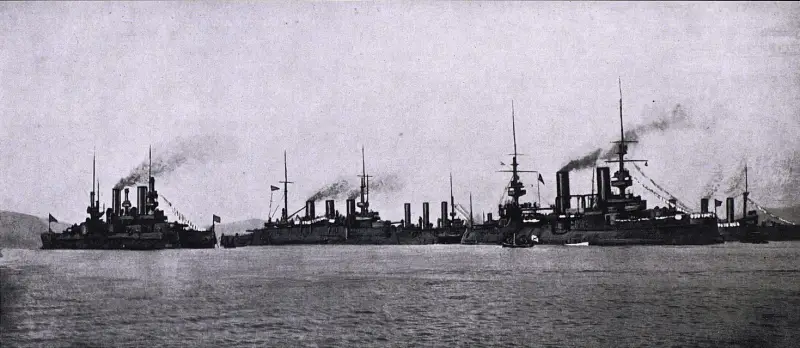
Russian squadron in Port Arthur. From the album of M. F. Schultz
Vice Admiral Makarov took care of maintaining secrecy, naval reconnaissance, and intensifying the activities of the Vladivostok cruiser detachment. Small detachments of high-speed destroyers began to be sent to the Yellow Sea to reconnoiter enemy forces. Clashes with the Japanese began.
Makarov expressed his readiness to give a decisive battle to the Japanese fleet, which caused confusion among the Japanese naval and land command. The transfer of Japanese troops was in jeopardy.
However, a tragic incident interrupted the restoration of the combat capability of the Russian fleet. On March 31 (April 13), the flagship battleship Petropavlovsk hit a mine and sank almost instantly. Makarov and his staff also died (The tragedy of the Russian fleet: the death of Admiral Makarov and Petropavlovsk).
This was a terrible blow for the Russian fleet. They could not find a suitable replacement for Makarov. Makarov turned out to be the only Russian naval commander who really tried to change the course of hostilities at sea, and accordingly in the war, in favor of Russia. The Russian Pacific squadron was paralyzed.
Immediately after the death of Makarov, the Commander-in-Chief of the Armed Forces of the Russian Empire in the Far East, Admiral E. I. Alekseev, arrived in Port Arthur. He took command of the fleet. On April 22, Rear Admiral V.K. Vitgeft was appointed commander of the fleet. He was the head of the naval department of the headquarters of the Tsar's governor and was not distinguished by his initiative. In a short period of time, the new command negated all the innovations that Makarov introduced. The Russian squadron froze in the internal roadstead. Even the duty of cruisers in the outer roadstead was cancelled.
The old rule “take care and not take risks,” which was established by the incompetent Admiral Alekseev, was restored in full and was in effect until the inglorious death of the Russian fleet. Leaving Port Arthur for Mukden due to the threat of encirclement, Alekseev instructed Vitgeft not to take active actions, due to the weakening of the fleet, and to limit himself to reconnaissance of cruisers and destroyers. And it was proposed not to expose light forces to “special risk.” The initiative at sea finally passed to the Japanese.
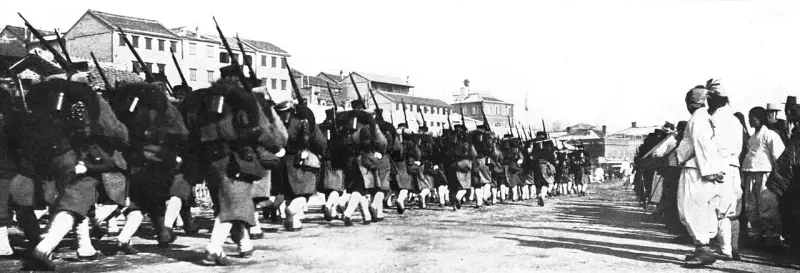
Japanese infantry during the occupation of Seoul. Korea, 1904
Land Theater
The initial task of the Manchurian Army was to distract Japanese troops, preventing the enemy from delivering a powerful blow to Port Arthur. After reliable information was received about the landing of Japanese troops in the ports of the western coast of Korea and their advance to the north, the temporary commander of the Russian Manchurian Army, General N.P. Linevich, received an order to detain the enemy at the border of the Yalu River. This should have allowed the completion of the concentration of Russian troops arriving in Western Siberia and European Russia in the area of the cities of Mukden - Liaoyang, and prevent the Japanese from sending superior forces to Port Arthur.
These days, the commander-in-chief of the Russian forces in the Far East, Admiral Alekseev, received instructions from Emperor Nicholas II regarding the conduct of the war. The Tsar proposed to direct all efforts to ensure the concentration of troops and hold the Chinese Eastern Railway. In general, the instructions of the Russian monarch were vague and doomed the Russian army to inaction. The Russian army, like the navy, lost strategic initiative, allowing the enemy to impose its will.
Fearing the Russian fleet, especially when it was led by the determined Makarov, the Japanese command slowed down the process of transferring troops to Korea. Only on March 29, 1904, the last formations of the 1st Army of General Kuroki completed the landing. The spring thaw made the roads, which were already few in number, impassable. Thus, the advanced units of the Japanese army made the 240-verst journey from Seoul to Pyongyang in only 24 days. Only in the twentieth of April the advanced forces of the Japanese army appeared on the left bank of the Yalu River.
When moving, the Japanese troops did not meet with serious resistance, although they expected it. An advanced Cossack cavalry detachment under the command of General P. I. Mishchenko was located in North Korea. The Cossack detachment consisted of 22 hundreds of Trans-Baikal and Ussuri Cossack cavalry and one Cossack artillery battery. The Cossacks received the task of reconnaissance and advanced to 100 km south of the Yalu River. Therefore, on the territory of the Korean Peninsula, there were only minor clashes between Cossack patrols and advanced units of the Japanese army.
Although, taking into account the advantage of the Russian army in cavalry and the lack of a developed road network in Korea, the Russian command could, with the help of cavalry, significantly slow down the enemy’s advance. But this advantage was not used.
The first relatively serious clash occurred at Chenshen. On the Russian side, six hundred dismounted Cossacks (one Cossack regiment) took part in the battle, on the Japanese side - 5 infantry battalions, 7 cavalry squadrons, an engineer company and 18 field guns. The outcome of the battle was decided by Japanese artillerymen. They fired at the positions of the Cossacks, and they mounted their horses and retreated to the location of the main forces on the Yalu River. There were no losses.
The retreat of Russian troops from Korea made an extremely unfavorable impression on the local population. In addition, the Russian patrols were unable to determine even the approximate composition of the Japanese troops on the march. Combat contact with the Japanese was lost, which deprived the Russian command of information about the enemy. Thus, the forecasts of the Russian command that in the third month of the war 10 enemy divisions would reach the South China Railway did not come true. In fact, only 3 Japanese divisions reached the Yalu River.
The Russian Manchurian army mobilized and deployed very slowly. Everything rested on real, rather than paper, planned above, carrying capacities of the Siberian Railway. During the first month and a half of the war, the average daily growth of the Far Eastern army group was about one infantry battalion, 0,5 hundreds of cavalry and 3 guns. Only by the end of April Russia and Japan were able to prepare for the first battles in the land theater of military operations.

Troops march to the Korean-Manchurian border, a military train crosses Lake Baikal. From the Spanish magazine "Art Illustration". Frederic de Hanen
The forces of the parties
The eastern detachment of the Manchurian Army under the command of General Mikhail Ivanovich Zasulich at the turn of the Yalu River consisted of selected military units in combat terms. It included the 3rd and 6th East Siberian Rifle Divisions with their artillery brigades (2nd Siberian Army Corps) - 20 rifle battalions and 62 field guns. The detachment also included the Transbaikal Cossack brigade, the Argun and Ussuri Cossack regiments (24 Cossack hundreds in total), a sapper company and a telegraph team. In total, the detachment numbered 20–23 thousand people.
The Japanese 1st Army, under the command of General Kuroki, consisted of three divisions: the 2nd and 12th Infantry Divisions and the Guard. The divisions included 48 battalions, 15 squadrons and 180 guns (according to other sources - 128 guns). In total, more than 60 thousand Japanese soldiers were concentrated in the area of the city of Yingzhou (Izhu). In addition, Kuroki's army was constantly replenished. The army also had more than 16 thousand porters (they replaced military transport). The 1st Army was faced with the task of pushing the Russian defensive forces away from the border and opening the road to Southern Manchuria.
At the same time, the Japanese 2nd Army under the command of Yasukata Oku was in the Qinampo area in full readiness to cross by sea and land on the Liaodong Peninsula. The army was waiting for the order of the commander-in-chief, Marshal Iwao Oyama. The commander-in-chief could give such an order only if the 1st Army successfully broke through the Yalu River and blocked the Russian fleet in Port Arthur.
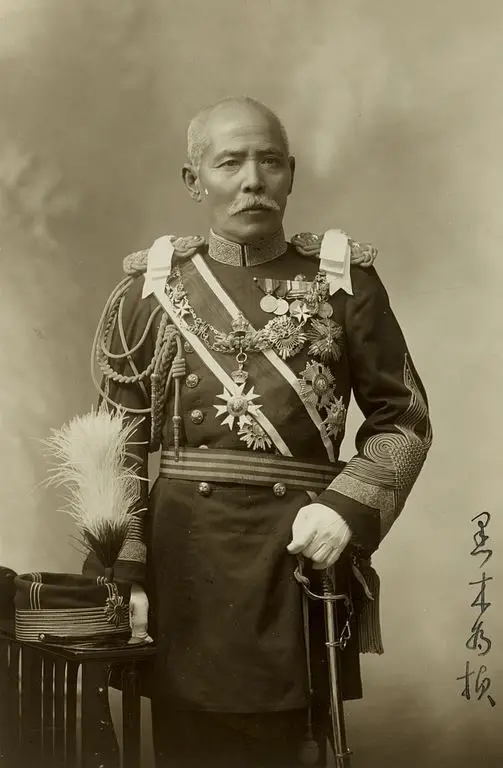
Kuroki Tamemoto (1844–1923). During the Russo-Japanese War he commanded the Japanese 1st Army. Having landed his troops at Chemulpo in mid-February 1904, Kuroki occupied Korea and forced the Russian detachment to retreat at the Battle of the Yalu River. He took part in the battles of Liaoyang, on the Shah River and Mukden.
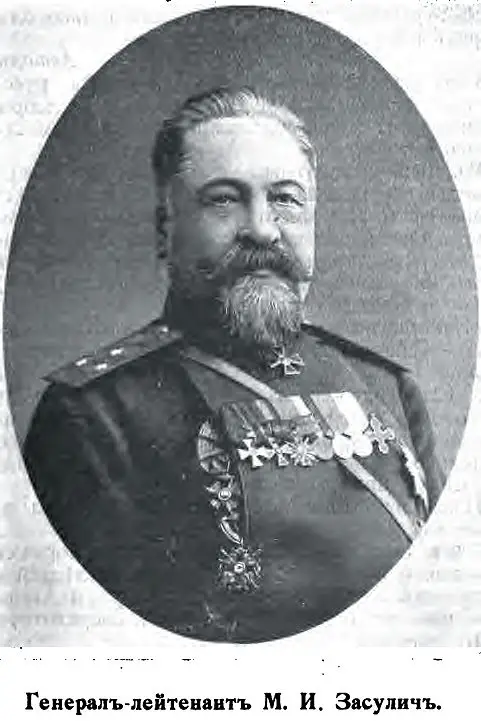
Before the start of the Russo-Japanese War, M. I. Zasulich (1843–1910) received command of the 3nd Siberian Corps on February 1903, 2, with which he took part in the war. Appointed head of the Eastern detachment of the Manchu Army, concentrated at Fynhuangchen, he was supposed to defend the Yalu River. Here Zasulich had to fight the first battle with the enemy, the outcome of which was supposed to have important strategic and moral consequences for our army, but the uncertainty of the directives and the awareness of the weakness of the forces, as well as their distance from the main forces of the army, caused him extreme confusion, which resulted in his defeat detachment near Tyurenchen and a disorderly retreat to Fynhuanchen. With the same extreme indecision, lethargy and passivity, he led the actions of the corps in the battles of Simuchen, Liaoyang, Shah and Mukden, trying not to get involved in stubborn battles and most of all thinking about an organized retreat. All this made his name very unpopular in the army. However, he was awarded the Order of St. Anne, 1st class with swords (1904) and the Order of St. Vladimir, 2nd class with swords (1905). On April 6, 1906, Zasulich was promoted to infantry general and was dismissed from service due to illness.
Location of troops
On April 18, 1904, the commander of the Eastern detachment, General Zasulich, received an order from the commander of the Manchurian Army Kuropatkin to make it difficult for Japanese troops to cross the Yala and their further advance through the Feishunlinsky mountain range. It was also necessary to find out the goals and direction of the Japanese movement. At the same time, Zasulich had to avoid a decisive battle with superior enemy troops and, under strong pressure, retreat to the main forces of the Manchurian army to Liaoyang.
Thus, the Russian command underestimated the strategic importance of the line on the Yalu River. The Japanese army was not going to be stopped at a line convenient for defense. Thus, the Yalu River had no fords; it could only be crossed by boats. There was a ford on the tributary of the Yalu River Eikho (Aikhe), but only cavalry could cross it. And the Japanese cavalry was a weak point.
The lack of reliable information about the location of enemy forces did not allow Zasulich to calculate the direction of the main attack of the 1st Army and correctly position the Russian troops. Zasulich's eastern detachment was scattered over an almost 100-kilometer area. About half of the Eastern detachment was located at the place where the main forces of the Japanese army were concentrated. At the Sakhodzy-Tyurenchen position, the defense was held by 10 battalions, 5 cavalry hunting teams, 32 guns and 8 machine guns.
A regiment with 6 guns was stationed in the Potetynza area, which moved 1 battalion with 4 guns to Chingou. The right flank was covered by cavalry. Behind the left flank of the position, at the mouth of the Ambikhe River, Lechitsky’s detachment was located, and further along the Yalu River there were horse patrols. Near the village of Tenzy there was a reserve - 5 battalions and 8 guns. The remaining parts were stretched north along the river.
The Russian position on the right bank of the Yalu River was very convenient for defense. The right, mountainous bank rose above the lowlands of the left bank. With enough troops and good engineering equipment, these positions could become impregnable or extremely difficult for the Japanese to break through. However, the contempt of some of the generals for military innovations was fully reflected here.
The opportunities for strengthening the position that nature provided were not used. Contempt for trenches led to the fact that they were built for only a few companies. In addition, they were almost uncamouflaged and open, not protected from shrapnel fire. The guns were located openly on mountain slopes facing the enemy. This gave the Japanese the opportunity to visually detect Russian artillery positions even before the start of the battle.
No artillery reconnaissance was carried out. The soldiers did not disguise their presence, and the Japanese could easily determine the Russian positions. Due to the stretched forces, the depth of defense was low. In addition, due to the lack of roads, forested mountains and ravines, maneuver of the troops was difficult. In such conditions, communication was of great importance. But the Japanese interrupted the telegraph communication established along the extended front of the Eastern Detachment at the first contact.
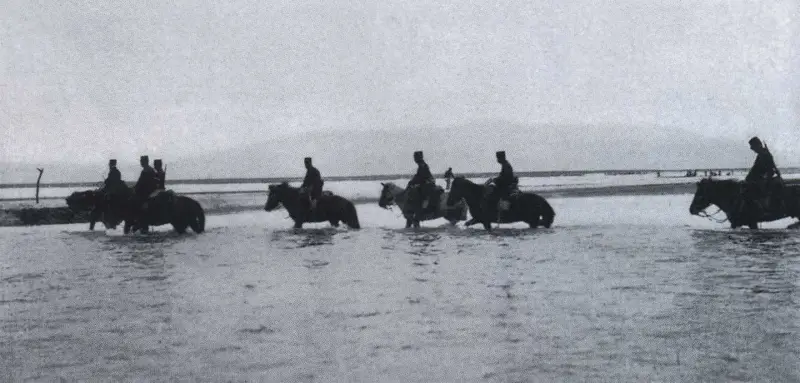
Japanese cavalry crossing the Yalu River
Having assessed the situation, General Kuroki decided to strike with all his forces in the Tyurenchensky sector. Japanese intelligence officers and agents (the Japanese widely used the Chinese and Koreans for espionage) established that above the mouth of the Eiho River, which flowed into the Yalu, the Russian command conducted surveillance only with the help of horse patrols. The crossing of significant forces here made it possible to cover the Tyurench position of the Russian detachment from the flank. Therefore, two divisions were advancing in this direction - the Guards and the 12th. The 12th Division was supposed to make a flanking maneuver.
After the first success, Kuroki hoped to go to the rear of the Russian detachment, cut it off from the main forces of the Manchurian army and destroy it, and then move to Fenghuanchen, ensure the landing and deployment of Oku's 2nd Army in Biziwo. The Japanese were able to keep the main direction of the attack secret and ensure complete superiority in forces. For the offensive in the Tyurenchen sector, the Japanese command created a five-fold superiority in infantry and a three-fold superiority in artillery.
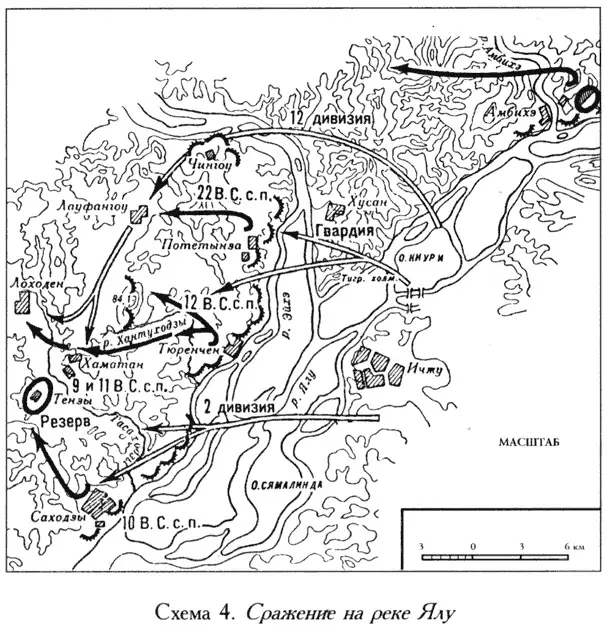
Battle
On the night of April 26, 1904, Japanese troops captured the islands of Kiuri and Syamalinda. The Russian hunting teams that occupied them were driven out. By April 29, the Japanese had completed the construction of several crossings and placed several strong artillery batteries on the islands, which ensured the crossing of troops. Japanese artillerymen had maps with Russian positions on them on the other side of the Yalu River. The right-flank 12th Division was advanced to the Eihe River, west of Khusan. She received the task of covering the left flank of the Russian detachment.
On the night of May 1 (April 18, old style), the main forces of the Japanese army crossed the river. The crossing took place in complete silence of the Russian batteries, which greatly surprised the Japanese. Not a single shot was fired from the Russian positions. The Japanese believed that the Russians were retreating or wanted to fire a volley at point-blank range. Only after the Japanese began to build the pontoon bridge did the Russian artillerymen try to stop it. However, their positions, which were completely open, were quickly covered. The Russian batteries fell silent.
Early in the morning, Japanese artillery carried out a strong artillery barrage. The fire was carried out by 20 howitzers and 72 field guns. Many guns fired aimed fire along the opposite bank, at previously identified Russian positions. All three Japanese divisions then went on the attack. They lined up in columns, covered by thick chains of riflemen.
At a front of 10 km against them there were only 5 infantry battalions and 2 hunting teams with 15 field guns and 8 machine guns. The Japanese advanced in dense formations, and only due to the weakness of the enemy's rifle and artillery fire and the lack of mountain artillery among the Russians did they suffer rather small losses.
By 8 o'clock, Japanese troops forced the Russians to retreat from Tyurenchen and another hour later they occupied Potetynza with the forces of the Guards Division. At the same time, the 12th Division crossed Eihe and cut the only road to Chingou, covering the left flank of the Russian position. The Russian cavalry detachment, which covered the left wing of the Russian position on the Yalu, instead of trying to strike the flank and rear of the enemy troops crossing the river, retreated for no apparent reason.

Japanese troops land at Nampho Bay before the Battle of the Yalu River
General Zasulich, without thinking about counterattack actions (he showed extreme confusion that day), and under the threat of encirclement, gave the order for a general retreat of the Eastern detachment.
To cover the retreating troops, two battalions and 8 guns of the 11th East Siberian Regiment were advanced from the reserve. They occupied height 84. The soldiers of the 11th East Siberian Rifle Regiment covered themselves with eternal glory on this day. Giving other troops the opportunity to get out from under attack, the 11th East Siberian Regiment stood to the death and was surrounded. The field battery and the machine gun company fought to the last and “went down.” The regiment commander and almost the entire 3rd battalion died a heroic death.
Correcting the mistakes of the command, two battalions of Siberian riflemen held back the onslaught of almost two Japanese divisions for half a day. The remnants of the regiment at 4 o'clock in the afternoon went to break through the encirclement and struck with bayonets. The Japanese did not accept hand-to-hand combat, and the Siberian riflemen were able to break through into the mountain gorge. The enemy pursued the Russian soldiers, but ran into an ambush, lost many people and retreated. Only a few dozen soldiers and two company commanders remained from the regiment.
Officer Mikhail Ivanov, a participant in the battle, recalled:
When the regimental priest Father Stefan Shcherbakovsky, walking with a cross in his hands, fell wounded in the arm and chest, the regimental clergyman Osip Perch, not one step behind his priest, picked up Father Stefan and carried him out of the battle. Awarded the St. George Cross.
The regimental banner was carried by the flag bearer, non-commissioned officer Peter Minzar, under the cover of a platoon under the command of Second Lieutenant Bogachevich. I led 156 riflemen into battle. 96 were killed, 45 were wounded, 15 escaped unscathed, including me, despite the fact that during the five hours of battle and three attacks I never sat down or was covered by anything... only by the will of God was it possible to save me.”
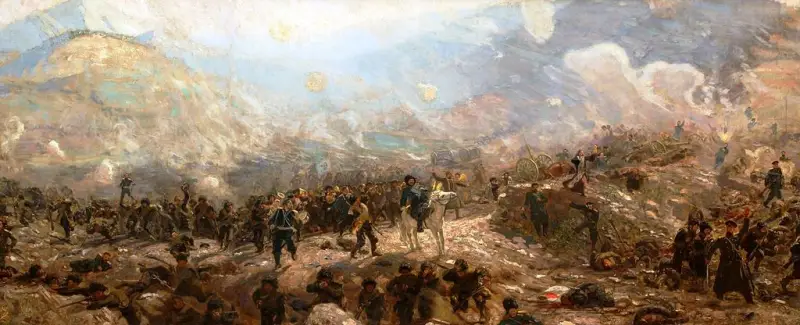
Yu. I. Repin “Turenchen. In glorious death there is eternal life" (11th East Siberian Rifle Regiment in the Battle of Tyurenchen)
Results
The Eastern detachment retreated in disarray to the Fenshulylinsky Range, losing most of the guns. The Japanese troops, following in the wake of the Eastern Detachment, advanced into the Fynhuangchen area. The Croek 1 Army completed its initial combat mission.
Zasulich's detachment lost about 2 people (according to other sources - 780 officers and 55 soldiers) killed, wounded, captured and missing. 2 field guns and all 122 machine guns were lost. The guns could not be removed from the positions, since the riding horses were killed by enemy fire, and the gunners disabled the guns.
Japanese troops lost 1 people (according to their data). Apparently, Japanese losses are somewhat underestimated.
The defeat of the Russian troops was caused by several reasons. Intelligence was poorly organized. The positions were not prepared in engineering terms. Zasulich did not use Kuroki’s slowness and excessive caution to regroup his forces; he made a mistake with the main direction of the enemy’s attack - he was expecting it at Sahodza. The eastern detachment was stretched over a long distance, and only about 25 thousand people fought against the striking fist of the Japanese army of 30-8 thousand bayonets.
When the direction of the enemy's main attack became clear, the Russian command did not try to pull all its forces to the threatened area and launch a counteroffensive, using cavalry to attack the enemy's flank and rear. Zasulich did not create a number of rear and intermediate positions, relying on which it was possible to apply mobile defense tactics, inflicting serious damage to superior enemy forces with small forces (this tactic was used by the Boers in the war with the British).
Also, Zasulich’s initiative was suppressed by the commander of the Manchurian Army Kuropatkin, who gave a lot of instructions, often very petty. As a result, Zasulich acted extremely indecisively, sluggishly and passively (he continued to act in the same way).
The defeat on the Yalu River was of strategic importance. The Japanese 1st Army overthrew the Eastern Detachment and broke into operational space. The Japanese cleared a convenient path for themselves to Southern Manchuria and took the first step to seize the strategic initiative in the land theater. Now almost the entire southern coast of the Liaodong Peninsula was open to the landing of amphibious forces.
The Japanese command was able to begin the siege of Port Arthur. Having advanced to Fynhuanchen, Kuroki's army shackled Kuropatkin's Manchurian army and fully ensured the landing and deployment of the 2nd and 3rd Japanese armies.
In addition, the first victory on land, albeit over insignificant Russian forces, greatly raised the morale of the Japanese army. The Japanese had not yet encountered the Russians in battle (they did not fight with the first-class European army), and this experience played a large positive role for further hostilities.
At the same time, the first defeat on land undermined the morale of the Russian army.
On the one hand, the positive thing was that the Russian command ceased to suffer from sarcastic moods. The Japanese showed themselves to be a skillful and dangerous enemy. There was an understanding of the advantage of fire over a bayonet strike, the need to build field fortifications and position artillery in closed positions.
On the other hand, the bad thing was that now the Russian command began to overestimate the enemy. The mania for flanking the enemy became the scourge of the Russian command.
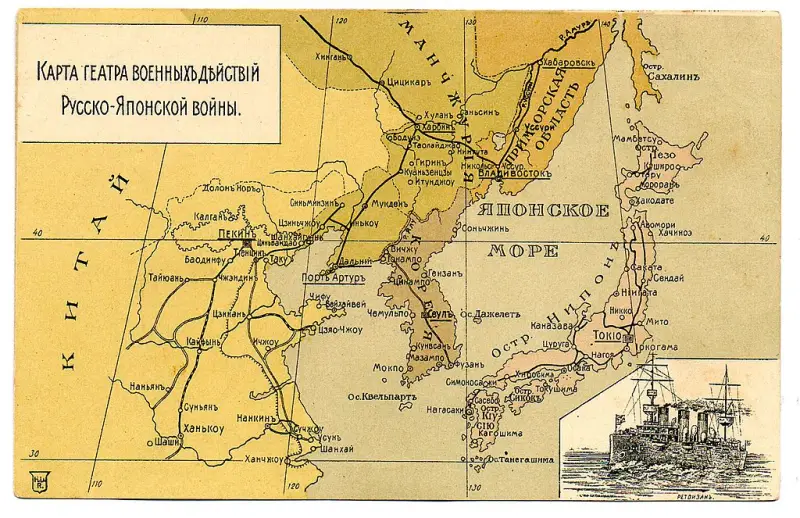
Information